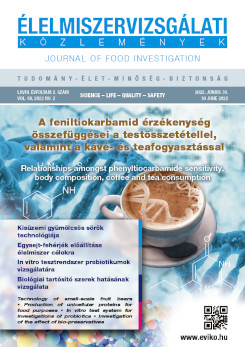Application of an in vitro test system for the selection of probiotic bacterial strains
Main Article Content
Absztrakt
The aim of our studies was to evaluate in vitro methods for the simple and efficient selection of putative probiotic bacterial strains. Of the possible methods, the following were tested: culturing on selective media, Gram staining, catalase assay, hemolytic, clonality and aggregation ability, gastric acid tolerance and bile acid tolerance. A total of 217 bacterial strains isolated from raw sheep’s milk, curdled milk and sheep’s cheese samples produced in Transylvania were included in our experiments. Isolates with hemolytic activity, as well as those exhibiting Gram-negative or catalase-positive phenotypes not characteristic of probiotics were excluded from our studies. Based on the results of RAPD-PCR studies suitable for the detection of individual-level polymorphisms, a total of 34 clone classes and 57 strains with unique RAPD patterns were identified. From each of the 34 clone classes thus narrowed, one strain was selected and tested for its aggregation ability, as well as its gastric acid and bile acid tolerance. High aggregation values above 70%, typical of probiotic strains, were measured in the case of a total of six isolates. In the course of the presence-absence studies conducted on the surface of solid media supplemented with acid or bile acid, it was possible to select several strains specifically tolerant to acid or bile acid. Based on our results, isolates to be included in further tests, e.g., in antibiotic resistance and antimicrobial activity assays, were selected.
Letöltések
Article Details
Hivatkozások
Hill, C., Guarner, F., Reid, G., Gibson, G.R., Merenstein, D.J., Pot, B., Morelli, L., Canani, R.B., Flint, H.J., Salminen, S., Calder, P.C., Sanders, M.E. (2014): The International Scientific Association for Probiotics and Prebiotics consensus statement on the scope and appropriate use of the term probiotic. Nature Reviews Gastroenterology and Hepatology 11 pp. 506-514. https://doi.org/10.1038/nrgastro.2014.66[2] Fijan, S., Frauwallner, A., Varga, L., Langerholc, T., Rogelj, I., Lorber, M., Lewis, P., Povalej-Bržan, P. (2019): Health professionals’ knowledge of probiotics: an international survey. International Journal of Environmental Research and Public Health 16 pp. 3128. https://doi.org/10.3390/ijerph16173128[3] Szakály, S. (2004): Probiotikumok és Humánegészség. Vissza a Természethez! Magyar Tejgazdasági Kísérleti Intézet, Mosonmagyaróvár.[4] European Parliament, Council of the European Union (2003): Regulation (EC) no. 1831/2003 of the European Parliament and of the Council of 22 September 2003 on additives for use in animal nutrition. Official Journal of the European Union L268 pp. 29-43.[5] Papadimitriou, K., Zoumpopoulou, G., Foligné, B., Alexandraki, V., Kazou, M., Pot, B., Tsakalidou, E. (2015): Discovering probiotic microorganisms: in vitro, in vivo, genetic and omics approaches. Frontiers in Microbiology 6 pp. 58. https://doi.org/10.3389/fmicb.2015.00058[6] Williams, C.F., Walton, G.E., Jiang, L., Plummer, S., Garaiova, I., Gibson, G.R. (2015): Comparative analysis of intestinal tract models. Annual Review of Food Science and Technology 6 pp. 329-350. https://doi.org/10.1146/annurev-food-022814-015429[7] Antal, O., Némethné Szerdahelyi, E., Takács, K. (2020): In vitro humán emésztési modellek alkalmazása a táplálkozástudomány területén (Application of in vitro human digestion models in the field of nutrition science). Élelmiszervizsgálati Közlemények - Journal of Food Investigation 66 pp. 3141-3157.[8] Del Re, B., Sgorbati, B., Miglioli, M., Palenzona, D. (2000): Adhesion, autoaggregation and hydrophobicity of 13 strains of Bifidobacterium longum. Letters in Applied Microbiology 31 pp. 438-442. https://doi.org/10.1046/j.1365-2672.2000.00845.x[9] García-Cayuela, T., Korany, A.M., Bustos, I., de Cadiñanos, L.P.G., Requena, T., Peláez, C., Martínez-Cuesta, M.C. (2014): Adhesion abilities of dairy Lactobacillus plantarum strains showing an aggregation phenotype. Food Research International 57 pp. 44-50. https://doi.org/10.1016/j.foodres.2014.01.010
Sedláčková, P., Horáčková, Š., Shi, T., Kosová, M., Plocková, M. (2015): Two different methods for screening of bile salt hydrolase activity in Lactobacillus strains. Czech Journal of Food Sciences 33 pp. 13-18. https://doi.org/10.17221/299/2014-CJFS[11] Pereszlényi, K. (2019): Tejsavbaktériumok genetikai azonosságának vizsgálata molekuláris markerekkel. Szakdolgozat. Széchenyi István Egyetem, Mosonmagyaróvár.[12] Torriani, S., Zapparoli, G., Dellaglio, F. (1999): Use of PCR-based methods for rapid differentiation of Lactobacillus delbrueckii subsp. bulgaricus and L. delbrueckii subsp. lactis. Applied and Environmental Microbiology 65 pp. 4351-4356. https://doi.org/10.1128/AEM.65.10.4351-4356.1999[13] Kos, B., Šušković, J., Vuković, S., Šimpraga, M., Frece, J., Matošić, S. (2003): Adhesion and aggregation ability of probiotic strain Lactobacillus acidophilus M92. Journal of Applied Microbiology 94 pp. 981-987. https://doi.org/10.1046/j.1365-2672.2003.01915.x[14] Xu, H., Jeong, H.S., Lee, H.Y., Ahn, J. (2009): Assessment of cell surface properties and adhesion potential of selected probiotic strains. Letters in Applied Microbiology 49 pp. 434-442. https://doi.org/10.1111/j.1472-765X.2009.02684.x[15] Tuo, Y.F., Yu, H.L., Ai, L.Z., Wu, Z.J., Guo, B.H., Chen, W. (2013): Aggregation and adhesion properties of 22 Lactobacillus strains. Journal of Dairy Science 96 pp. 4252-4257.https://doi.org/10.3168/jds.2013-6547[16] Prabhurajeshwar, C., Chandrakanth, K. (2019): Evaluation of antimicrobial properties and their substances against pathogenic bacteria in vitro by probiotic lactobacilli strains isolated from commercial yoghurt. Clinical Nutrition Experimental 23 pp. 97-115. https://doi.org/10.1016/j.yclnex.2018.10.001[17] Süle, J., Varga, L., Varga, K., Hatvan, Z., Kerényi, Z. (2022) Probiotikus baktériumtörzsek szelektálására alkalmas kísérleti rendszer egyes elemeinek kidolgozása (Developing basic elements of an experimental system for selection of probiotic bacterial strains). Magyar Állatorvosok Lapja 144 (közlésre benyújtva).[18] Pan, X.D., Chen, F.Q., Wu, T.X., Tang, H.G., Zhao, Z.Y. (2009): The acid, bile tolerance and antimicrobial property of Lactobacillus acidophilus NIT. Food Control 20 pp. 598-602.https://doi.org/10.1016/j.foodcont.2008.08.019[19] Vargas, L.A., Olson, D.W., Aryana, K.J. (2015): Whey protein isolate improves acid and bile tolerances of Streptococcus thermophilus ST-M5 and Lactobacillus delbrueckii ssp. bulgaricus LB-12. Journal of Dairy Science 98 pp. 2215-2221.https://doi.org/10.3168/jds.2014-8869[20] Valente, G.L.C., Acurcio, L.B., Freitas, L.P.V., Nicoli, J.R., Silva, A.M., Souza, M.R., Penna, C.F.A.M. (2019): Short communication: In vitro and in vivo probiotic potential of Lactobacillus plantarum B7 and Lactobacillus rhamnosus D1 isolated from Minas artisanal cheese. Journal of Dairy Science 102 pp. 5957-5961.https://doi.org/10.3168/jds.2018-15938[21] Yerlikaya, O. (2019): Probiotic potential and biochemical and technological properties of Lactococcus lactis ssp. lactis strains isolated from raw milk and kefir grains. Journal of Dairy Science 102 124-134. https://doi.org/10.3168/jds.2018-14983

